Norway is a long, narrow country on the northwestern edge of the European continent. The northern third of Norway lies above the Arctic Circle and is called the Land of the Midnight Sun. Because this region is so far north, it has long periods every summer when the sun shines 24 hours a day. Oslo, Norway’s capital and largest city, is in the southern part of the country.
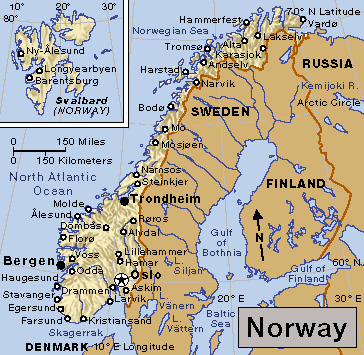
Most of the Norwegian people live near or along the sea. Winds warmed by the sea give the coast much warmer winters than other regions so far north, and snow melts quickly there. Even north of the Arctic Circle, nearly all of Norway’s harbors are free of ice the year around. Inland areas are colder, and snow covers the ground much of the year. For thousands of years, the people have used skis for travel over the snow. Today, skiing is Norway’s national sport. Most Norwegians learn to ski before they even start school.
Norway, along with Denmark and Sweden, is one of the Scandinavian countries. Vikings lived in all three countries about a thousand years ago. Vikings from Norway sailed west and established colonies in Iceland and Greenland. About A.D. 1000, Leif Eriksson (also spelled Ericson, Ericsson, or Eiriksson) sailed from Greenland and headed what was probably the first European expedition to the mainland of America.
Since the time of the Vikings, the Norwegians have been a seafaring people. Norway’s coast is famous for its many long, narrow inlets of the sea called fiords, which provide fine harbors. Rich fisheries lie off the west coast, and dried fish were an important export as early as the 1200’s. Norway began developing its great shipping fleet during the 1600’s. Today, Norway’s fishing and shipping industries rank among the world’s largest.
Norway is mostly a high, mountainous plateau covered by bare rock, and it has a relatively small amount of farmland. But the rivers that rush down from the mountains provide cheap electric power. Norway ranks among the leading countries in hydroelectric power generation. Norwegian manufacturing is based on this cheap power. Important products of Norway include chemicals, metals, petroleum, processed foods, and wood pulp and paper.
Government
Norway is a constitutional monarchy with a king or a queen, a Cabinet led by a prime minister, and a parliament. The government is based on the Norwegian Constitution of 1814, which divides the government into three branches—executive, legislative, and judicial. The prime minister is the actual head of the government. The monarch has little power.
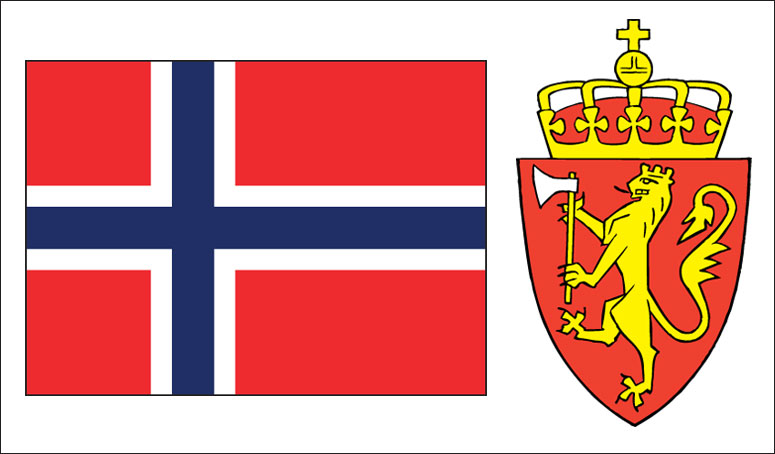
Norway's national anthem
The monarch usually appoints the leader of the strongest political party or coalition (group of parties) in the parliament to be prime minister. Other high government officials, including judges and county governors, are appointed by the monarch on the advice of the Cabinet. Like the other Scandinavian countries, Norway has a government official called an ombudsman. This official investigates complaints by citizens against government actions or decisions. See Ombudsman.
National government.
Executive power in the Norwegian government is exercised by the Cabinet, also known as the Council of State. It consists of the prime minister and a number of other officials, each of whom heads a department or ministry. The monarch officially appoints the Cabinet members, but they are actually selected by the party or coalition in power in the parliament. To keep the powers of the executive and legislative branches separate, Cabinet members cannot also be members of the parliament.
The Cabinet is responsible for forming government policies. A Cabinet remains in office as long as it has the support of a majority of the parliament. The Cabinet must resign if it loses a vote of confidence in the parliament. If a vote of no confidence or some other government crisis occurs, an alternate Cabinet—usually from a minority party—is appointed to govern during the rest of the parliament’s term.
The parliament, Norway’s lawmaking body, is called the Storting. It consists of 169 members elected to four-year terms. The people directly elect 150 of the members. The remaining 19 members are chosen from national electoral lists. The Storting passes new laws and amends and repeals existing laws. It also prepares the national budget and sets tax rates.
Courts.
The highest court is the Norwegian Supreme Court. Courts of Appeal hear appeals of decisions made by the district courts. Each municipality also has a Conciliation Board, which tries to settle disputes before they go to court. This body consists of three people elected to four-year terms.
Local government.
Norway has 11 counties, one of which is the city of Oslo. Each of the counties, except Oslo, has a governor. Norway’s cities, towns, and village districts elect councils of varying size to four-year terms. These councils select a chairman, or mayor, who serves two years.
Politics.
Norway has several major political parties. Traditionally, the largest has been the social democratic Labor Party. Members of the Labor Party favor social welfare programs, and they also favor government action to foster economic growth and full employment. The Conservative Party’s members support lower taxes and less government control of the economy. The Christian People’s Party is a center-right party whose members promote democracy based on a Christian outlook.
Norway’s other major political parties include the Center Party, the Liberal Party, the Progress Party, and Socialist Left Party. All Norwegians who are at least 18 years old can vote.
Armed forces.
Norway has an army, a navy, an air force, and a reserve force called the Home Guard. Norwegian men and women between the ages of 19 and 44 are required to serve in the armed forces for up to 19 months.
People
Ancestry.
The Norwegians are a Scandinavian people, closely related to the Danes and the Swedes. The people of Norway have strong ties with Americans. From the mid-1800’s to the early 1900’s, more than 750,000 Norwegians migrated to the United States in search of better job opportunities. No other country except Ireland has provided the United States with so many immigrants in proportion to population.
The Sami (formerly known, to outsiders, as Lapps) are concentrated in far northern Norway (see Sami). Several thousand people of Finnish ancestry also live in that region. Norway also has many immigrants. They include people from other European nations, the Middle East, Pakistan, the Philippines, Somalia, and Thailand.
Loading the player...Reinlender folk dance
Language.
The Norwegian language has two forms—Bokmål and Nynorsk. They are similar enough for someone who speaks either form to understand a person who speaks the other. Both Bokmål and Nynorsk belong to the Scandinavian group of Germanic languages. Local school boards may select either as the chief form in a school, but all students learn to read both. The Sami also use their own language, which is similar to Finnish.
Loading the player...Pa Snei folk dance
Bokmål, also called Riksmål, is the major form used in the cities and towns, and in most Norwegian schools. Bokmål is a Norwegian form of Danish. It has almost the same vocabulary and spelling as Danish, but is pronounced much differently. Bokmål developed during Norway’s political union with Denmark, which lasted from 1380 to 1814. During that period, it replaced Old Norse, the early Norwegian language.
Nynorsk, originally called Landsmål, was created during the mid-1800’s as a reaction against the Danish influence. Nynorsk was based on the many dialects (local forms of speech) that developed in rural areas during Norway’s union with Denmark.
Way of life
City life.
About 85 percent of Norway’s people live in urban areas. But Norway is less urban than Denmark and Sweden, where about 90 percent of the people live in cities. Oslo is Norway’s capital and largest city. Other large cities include Bærum, Bergen, Fredrikstad, Kristiansand, Sandnes, Stavanger, and Trondheim. See the articles on Norwegian cities listed in the Related articles at the end of this article.

Norwegian cities sprawl into surrounding suburbs, but they are smaller than most other European cities. They have fewer high-rise commercial buildings and lack the fast pace of life often found in cities of other industrial nations. 
Norway’s high standard of living and its social welfare system have kept the cities free of slums and substandard housing. Most Norwegians and immigrant workers live in modern apartment buildings in or near the principal urban areas. Wealthier Norwegians often own single-family homes built of wood. A number of Norwegians also own small cottages along the coast or in the mountains, which they visit on weekends or holidays.
Although Norway’s cities have bus and train services, traffic congestion is a problem. Norway has little industrial pollution because of its extensive use of hydroelectric power and natural gas in industry. Unemployment is extremely low by international standards. Many of Norway’s immigrants work in low-paying jobs in the cities. Their presence has caused discontent among some Norwegians because of the benefits the immigrants get through the social welfare system.
Rural life.
About 15 percent of Norway’s people live in rural areas. The rural population is concentrated in southeastern Norway, which has gently rolling hills suitable for farming, and along the western coast, and in the northern regions. Many people who live in rural areas fish for a living. Some spend weeks or even months away from home on fishing ships in the North Sea and the North Atlantic Ocean. 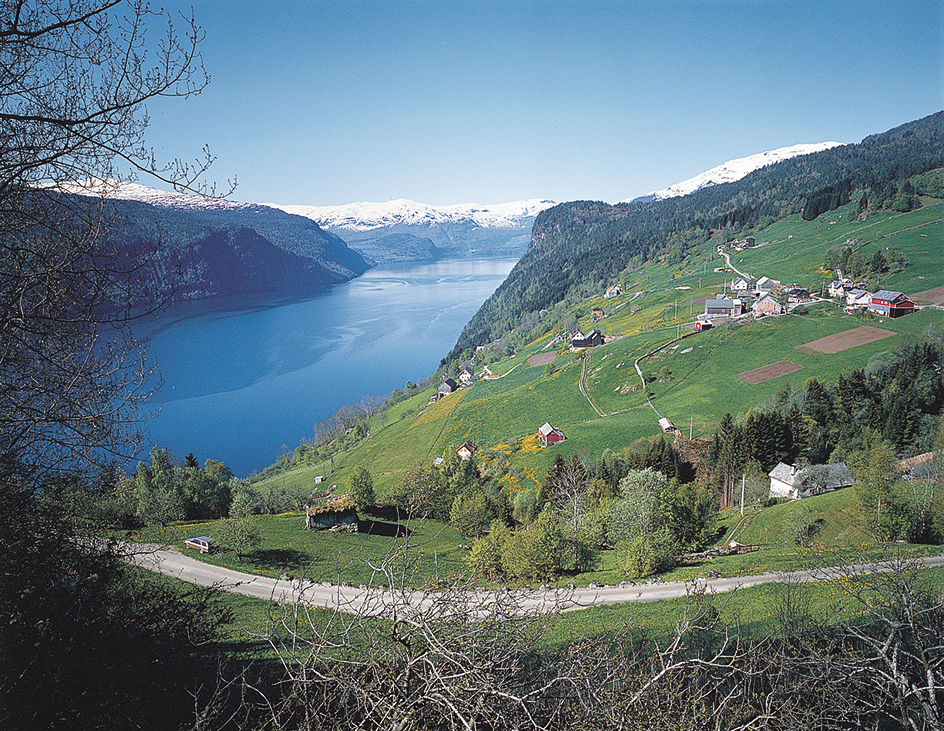
Many rural homes are old, wooden farmhouses that have been modernized. Almost all of them have electric stoves, refrigerators, and other appliances.
Norway’s numerous fiords, rivers, and mountains prevent many rural Norwegians from traveling easily. However, roads and tunnels built since the late 1900’s have helped connect parts of Norway that had been isolated. Snow and ice still make many roads impassable during much of the year. For these reasons, rural people rely heavily on boats and the country’s electrified railway system for transportation.
Food and drink.
Norwegians usually eat four meals a day, but many farm families have five. Breakfast generally includes cereal and open-faced sandwiches with cheese, jam, herring, marmalade, or sliced meat. Goat cheese is a favorite sandwich spread. Sandwiches are also eaten at lunch and at a late-evening supper. Dinner is usually the only hot meal of the day. It includes soup, meat or fish, potatoes, vegetables, and dessert. People in the cities and towns eat dinner in the evening. Some people in farm areas have dinner at midday.
Norwegians drink coffee throughout the day and especially at mealtimes. Many Norwegians also enjoy beer, which is sometimes served with a strong, colorless liquor called aquavit. Tea, milk, and soft drinks also are popular in Norway.
Recreation.
Outdoor sports are an important part of Norwegian life. Recreation areas lie within short distances of all homes. Skiing, Norway’s national sport, may have started there thousands of years ago as a means of crossing the snow-covered land. Many Norwegians take cross-country ski trips to the country’s mountains or wooded hills. Almost every town has a ski jump. The second most popular winter activity is ice-skating. Norwegians also have long enjoyed bandy, a form of hockey played by 11-player teams on large rinks. Soccer is the favorite summer sport. 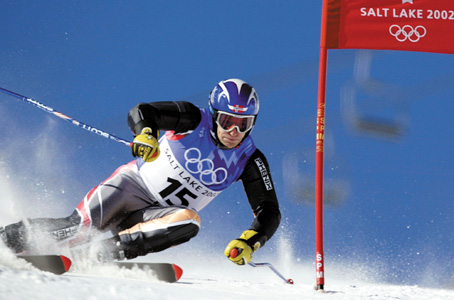
Norway’s forests and mountains provide many other recreational opportunities. On weekends, many Norwegians enjoy hiking through hills and forest areas. Some Norwegians travel to cabins in the mountains, where they may spend several weeks during the summer vacation season. Many adults also enjoy hunting. Sailing is popular along the coast. In addition, Norway’s numerous fiords, lakes, and rivers attract many fishing enthusiasts. Swimming is also a popular activity.
Social welfare.
The government of Norway provides the people with many welfare services. All people living in Norway who support children under the age of 18 are entitled to a child benefit, or family allowance. The government guarantees paid vacation for all employed people. Large families with medium or low incomes pay little or no national taxes, and their local taxes are reduced.
The National Insurance Act, which went into effect in 1967, combined many existing welfare programs. All Norwegians are required to take part in this combined plan. It includes old-age pensions, job retraining, and aid for mothers, orphans, widows, widowers, and people with disabilities. Another insurance plan provides free medical and hospital care, plus cash payments to employees during illness. The costs of these plans are shared by the insured people, their employers, and the national and local governments.
Religion.
The Norwegian Constitution establishes the Evangelical Lutheran Church as the nation’s official church, but other religions have complete freedom of worship. More than 80 percent of the people are Evangelical Lutherans. The government largely controls the Evangelical Lutheran Church. It appoints the pastors and church officials and pays their salaries.
Other religious groups in Norway include Baptists, Free Lutherans, Methodists, Pentecostals, and Roman Catholics. The Oslo region is home to a large Muslim community.
Education.
Almost all people in Norway can read and write. Norwegian law requires children from the age of 6 to 16 to go to school. The elementary school program lasts seven years. It is followed by three years of junior high school and three years of senior high school. Senior high school provides academic courses for those who wish to go on to college and also vocational courses.
Ås (near Oslo), Bergen, Oslo, Stavanger, Tromsø, and Trondheim each have a university. Another university has campuses in the counties of Vest-Agder and Aust-Agder in southern Norway. Schools of higher education also include a network of regional colleges, and several technical and other specialized institutions.
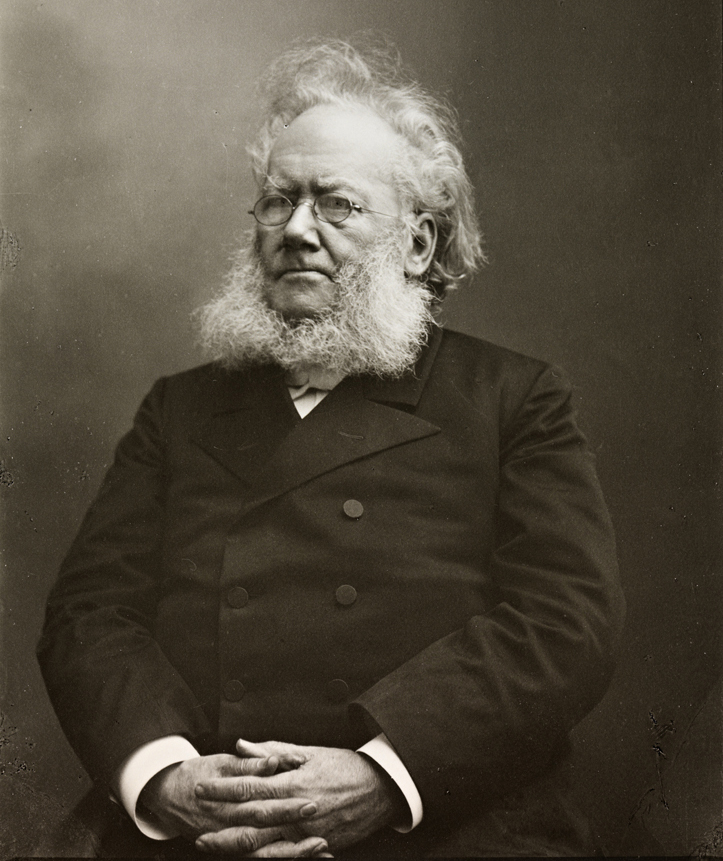
The University of Oslo Library is the largest library in Norway. Oslo also has the country’s largest city library. All cities and towns are required by law to have free public libraries. These libraries are partly supported by government grants.
Arts.
Norwegians have contributed much to the development of the arts. Henrik Ibsen’s realistic plays of the late 1800’s brought him worldwide fame as the father of modern drama. Three Norwegian writers—Bjørnstjerne Bjørnson, Knut Hamsun, and Sigrid Undset—have won the Nobel Prize in literature. 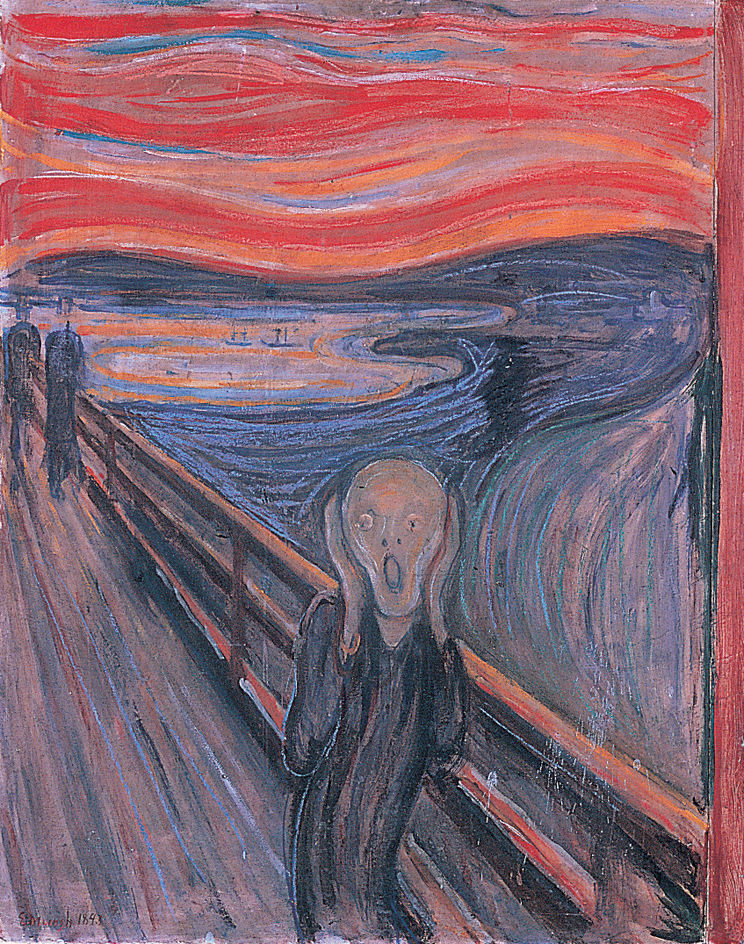
The painter Edvard Munch was a strong influence on the Expressionist art style of the early 1900’s. Statues by Gustav Vigeland, perhaps Norway’s greatest sculptor, stand in Oslo’s Frogner Park. Edvard Grieg, Norway’s best-known composer, used melodies from Norwegian folk songs and dances in his orchestral works. For more information on Norwegian artists, see the biographies listed in the Related articles at the end of this article.
The land
Land regions.
Most of Norway is a high, mountainous plateau. Its average height is more than 1,500 feet (457 meters) above sea level. Only about a fifth of Norway, including two major lowlands, lies lower than 500 feet (150 meters). Norway has three main land regions: (1) the Mountainous Plateau, (2) the Southeastern Lowlands, and (3) the Trondheim Lowlands.
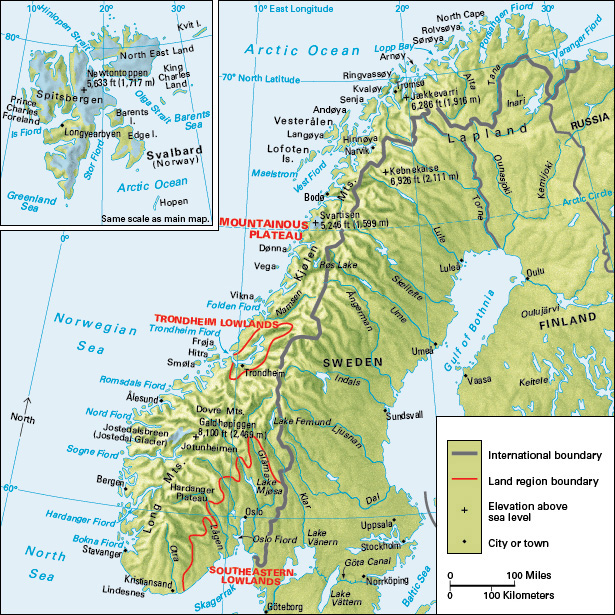
The Mountainous Plateau
is covered largely by bare rock that was smoothed and rounded by ancient glaciers. Glaciers also formed many lakes and deep valleys, especially in the 4,500-square-mile (11,700-square-kilometer) Hardanger Plateau, Europe’s largest highland plain. In Norway’s uplands above 6,500 feet (1,980 meters), permanent snow and ice cover about 1,200 square miles (3,110 square kilometers). The 188-square-mile (487-square-kilometer) Jostedalsbreen is the largest glacier in Europe outside Iceland.
In the narrow northern half of Norway, the Kjølen mountain range extends along the border with Sweden. Norway’s highest mountains rise in the wider southern half of the country. The Dovre Mountains extend in an east-west direction, and the Long Mountains rise to the south. The Jotunheimen range of the Long Mountains includes Galdhøpiggen, northern Europe’s tallest mountain, which rises 8,100 feet (2,469 meters).
The Southeastern Lowlands
consist mostly of the middle and lower valleys of the Glåma River, which is 372 miles (598 kilometers) long, and several other rivers. The rivers are used to float timber to pulp mills and sawmills. Their many waterfalls provide hydroelectric energy. The region also has narrow lakes, including Lake Mjøsa. Slopes are gentler than in most of the country, and the region is more suitable for farming and forestry. These lowlands are the most thickly settled part of Norway. They include Oslo, the capital and chief commercial, industrial, and shipping center.
The Trondheim Lowlands
include the lower ends of several wide, flat valleys. In addition to providing good farmland, the valleys also serve as important railroad routes to other parts of Norway and to Sweden.
The lowlands have long been a major region of settlement. Trondheim, founded in A.D. 998, was an important religious center in Norway during the Middle Ages. Today, it is a leading center of industry and trade.
Coast and islands.
Many long, narrow inlets of the sea indent the rocky coast of Norway. These inlets, called fiords, make the coastline one of the most jagged in the world. The longest, Sogne Fiord, extends inland for 127 miles (204 kilometers). Norway has a coastline of about 1,647 miles (2,650 kilometers). Including all the fiords and peninsulas, the full length of the coast is about 13,267 miles (21,351 kilometers), which is approximately half the distance around the world.
About 150,000 islands lie off the Norwegian coast. Some are only rocky reefs called skerries, which shield the coastal waters from stormy seas. The Lofoten and Vesterålen islands are the largest offshore island groups. The waters around them have rich cod fisheries. The famous Maelstrom current sweeps between the two outermost Lofotens, sometimes forming dangerous whirlpools. Jan Mayen and Svalbard are island possessions of Norway in the Arctic Ocean.
Climate
The climate of Norway is much milder than that of most other regions as far north, especially along the country’s west coast. Near the Lofoten Islands, for example, January temperatures average 45 °F (25 °C) higher than the world average for that latitude. Snow that falls along the coast melts almost immediately. The warm North Atlantic Current of the Gulf Stream keeps nearly all the seaports ice-free, even in the Arctic (see Gulf Stream).
During winter, Norway’s inland regions are colder than the coast because mountains block the warm west winds from the sea. Snow covers the ground at least three months a year. During the summer months, when the sea is cooler than the land, the west winds cool the coast more than the inland. The warmest summers are in the inland valleys of the southeast. Less rain falls inland than along the coast.
The far north, known as the Land of the Midnight Sun, has continuous daylight from mid-May through July. The period of midnight sun decreases southward, and there is no 24-hour sunshine south of the Arctic Circle. In winter, northern Norway has similar periods of continuous darkness. See Midnight sun.
Economy
Norway has a well-developed economy, with a low unemployment rate. Norway ranks as one of the leading countries in per capita gross domestic product (GDP)—that is, the total value of all goods and services produced within the country in a year. The GDP per capita can be determined by dividing the total GDP by the nation’s population.
Norway’s economy is partially free market and partially government controlled. The government controls the petroleum industry, and each year, invests some of the petroleum revenue. Norway plans for these investments to continue to provide some income after the oil reserves are exhausted.
Natural resources.
Norway’s waters provide its most valuable resources. Important petroleum and natural gas fields lie offshore in the North Sea. The offshore areas and the country’s rivers are rich in fish. Norway’s many swift mountain rivers are used to produce hydroelectric power.
Norway’s land is not rich in natural resources. About 60 percent of the country consists of mountains and plateaus that are covered mostly by bare rock. Only about 3 percent of Norway is farmland. Productive forests cover about 25 percent of the land.
Service industries
are those economic activities that provide services rather than produce goods. Service industries account for over half of Norway’s total GDP and about four-fifths of the country’s employment. Community, government, business, and personal services make up Norway’s leading service industry group. This group includes such activities as education, government, and health care. Hotels, restaurants, and shops greatly benefit from the millions of tourists who visit Norway each year. Most of these tourists come from Denmark, France, Germany, the Netherlands, Sweden, the United Kingdom, and the United States.
Mining
became a major Norwegian economic activity during the 1970’s, when the country began producing petroleum and natural gas from North Sea fields. Today, petroleum and natural gas account for a large part of the country’s income. Norway ranks as one of the world’s leading countries in the production of natural gas. However, since about 2000, Norway’s petroleum production has been diminishing.
Other mined products include aluminum, iron ore, limestone, nickel, titanium, and zinc. Coal is mined only in Svalbard, an island territory north of Norway.
Manufacturing
developed much later in Norway than in the major industrial countries. Those countries had their own coal to provide power with which to run machines. In the 1800’s, Norway had to import coal for its factories, which made manufacturing costly and held back its growth. By 1900, Norway had started to develop its sources of cheap hydroelectric power. The country’s factories turned to hydroelectric power to meet their needs. As a result, manufacturing in Norway expanded rapidly.
Today, manufacturing is one of Norway’s most valuable industries. The most important products include aluminum and other metals, petroleum products, processed foods, and ships. Norway is an important aluminum-producing country. This metal is processed from imported bauxite. The nation also produces electrical equipment, machinery, and wood pulp and paper.
Agriculture.
Farms in Norway lie on narrow strips of land in inland valleys and along the coast. Many Norwegian farmers have a second occupation so they can earn enough to support their families. Farmers own much of Norway’s commercial forests, and many are also loggers. Some farmers also fish commercially.
Dairy farming and livestock production account for most of Norway’s farm income. Farmers raise beef and dairy cattle, chickens, hogs, and sheep. Most cropland is used to grow livestock feed. The major crops of Norway include barley, fruits and vegetables, oats, potatoes, and wheat.
Fishing.
Norway has long been a great fishing country. Norwegian fishing crews bring in large numbers of blue whiting, capelin, cod, haddock, herring, mackerel, and saithe. Most of the country’s fishing catch comes from the Norwegian Sea.
Norway’s once-great whaling industry declined sharply during the 1960’s. Large catches by Norway and other major whaling nations made many kinds of whales increasingly scarce. In 1987, Norway joined an international moratorium (temporary halt) on commercial whaling (see Whale (Conservation)). It continued to take some whales for research purposes. In 1993, Norway resumed limited commercial whaling of minke whales, claiming they were no longer in danger. 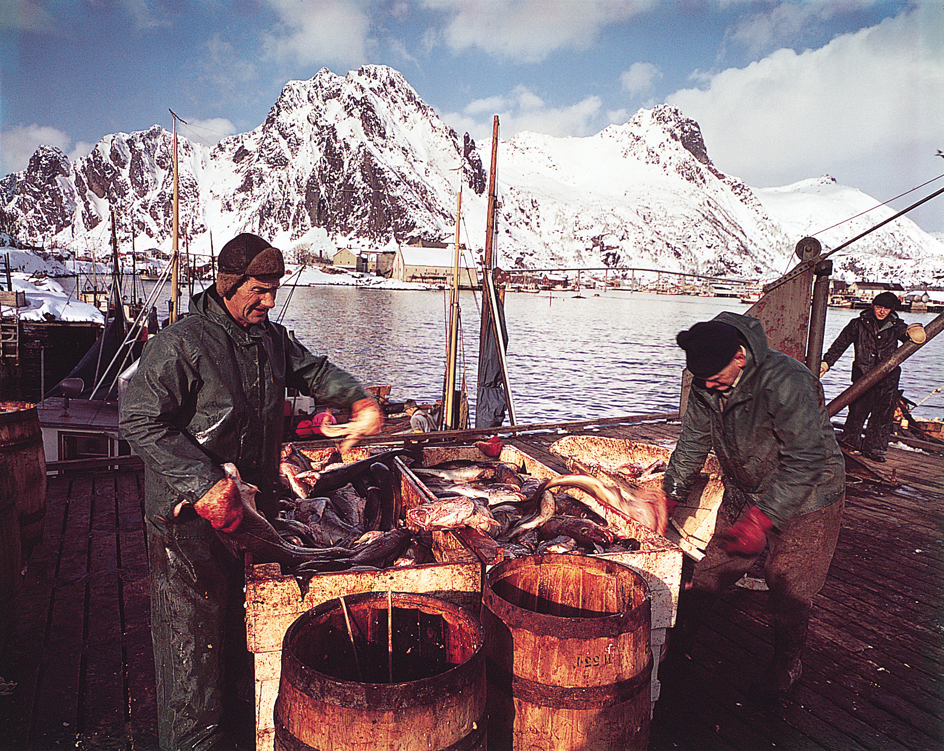
Forestry
has been an important industry in Norway for hundreds of years. Lumber became a major export in the 1500’s. Today, much timber is also used to make pulp and paper. The most important commercial trees are pine and spruce. Tens of thousands of miles of forest roads have been built to transport the logs. Timber is also moved by way of rivers. Much of the timber production comes from the southeastern portion of the country.
Energy sources.
Since the early 1900’s, hydroelectric stations have generated most of the power used in Norway’s industry and homes. But since the mid-1970’s, the extraction of Norway’s rich oil and natural gas deposits in the North Sea has led to more extensive use of petroleum products in industry and transportation. A small amount of energy comes from such solid fuels as coal, peat, and wood.
Foreign trade.
Norway depends heavily on foreign trade to help keep its standard of living high. The nation exports much more than it imports. Norway’s trade is one of the largest in the world in relation to its population. Norway, with limited natural resources, imports a wide variety of foods and minerals as well as automobiles, chemicals, machinery, and petroleum products.
Petroleum and natural gas rank as Norway’s chief exports, and Norway is one of the leading countries in the export of both products. Other exports include chemicals, fish, machinery, metals, transportation equipment, and wood pulp and paper. Norway’s large merchant fleet is also an important source of income for the country. The fleet provides shipping services for countries in all parts of the world.
Norway’s leading trade partners include Denmark, France, Germany, the Netherlands, Sweden, and the United Kingdom. Norway also trades with other European countries, China, and the United States.
Transportation.
Norway’s merchant fleet ranks as one of the world’s largest. Several hundred vessels link the coastal cities and towns of Norway. Inland, ferries cross many fiords and rivers.
Norway has an extensive road system. Almost all Norwegian households own an automobile. The world’s longest highway tunnel, the Lærdal Tunnel, opened in 2000. It extends 15.2 miles (24.5 kilometers) under the Jotunheimen mountain range in southern Norway.
The government owns and operates nearly all the railroads. It also owns part of the Scandinavian Airlines System, which flies throughout the world. Several airlines provide regular service to all parts of Norway. Oslo International Airport, which is about 30 miles (50 kilometers) north of Oslo in Gardermoen, is Norway’s busiest airport. Bergen, Stavanger, and Trondheim also have large international airports.
Communication.
Norway has dozens of daily newspapers. The most important dailies include the Aftenposten, Dagbladet, and Verdens Gang of Oslo; the Bergens Tidende of Bergen; and Adresseavisen of Trondheim. Many of the country’s newspapers support the views of one of the major political parties.
The government-owned Norwegian Broadcasting Corporation operates the national radio and television systems. The corporation is mainly funded by license fees on all television sets in the country. In 1992, Norway’s first nationally broadcast commercial television station, TV2, began operating. Now there are several commercial television and radio stations. Internet and cell phone usage has grown rapidly since the mid-1990’s.
History
Early days.
Almost 11,000 years ago, people lived along the northern and western coasts of what is now Norway. Most of the region was covered by thick ice sheets, which took thousands of years to melt. By 2000 B.C., people had started to settle there permanently. By the time of Christ, Germanic tribes had spread throughout the region, and they continued to arrive for hundreds of years. These tribes formed local and regional communities ruled by chiefs and kings.
The Viking period.
Viking sea raiders from the Norwegian communities spread terror through much of western Europe for about 300 years. Beginning with Great Britain and Ireland in A.D. 793, they attacked coastal towns and sailed away with slaves and treasure. The Vikings also sailed to the west and established colonies in the Faroe Islands and other North Atlantic islands. About 870, they explored farther west and colonized Iceland. Erik the Red brought the first group of settlers to Greenland about 985. About 1000, his son Leif Eriksson led what is believed to have been the first voyage of Europeans to the mainland of America. See Erik the Red; Vikings (The Norwegian Vikings). 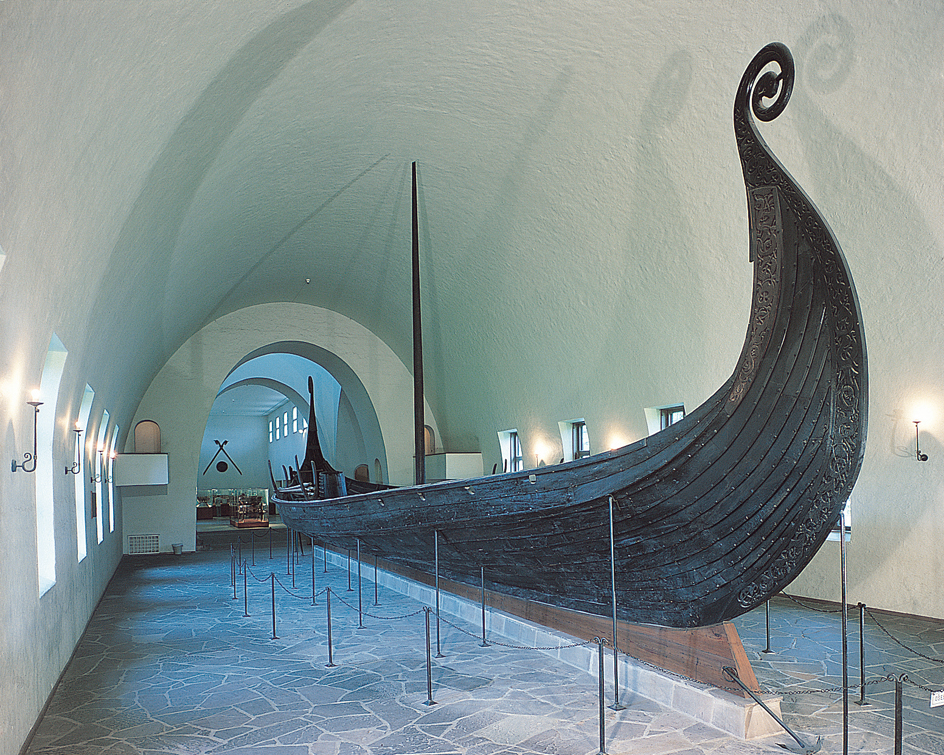
About 900, much of present-day Norway was united under Norway’s first king, Harald I (called Fairhair), or Harold I. He defeated many local chieftains and kings, and others recognized his leadership. King Olav I Tryggvason began the widespread conversion of Norway to Christianity in the 990’s. In the early 1000’s, Olav II achieved full Norwegian unity and firmly established Christianity. He became recognized as Norway’s patron saint soon after his death in 1030.
The Viking period ended around 1100. The church grew in power, foreign trade expanded, and religious and trading centers became important cities. Political confusion and bitter struggles for royal power also developed. Beginning in 1130, many regional leaders claimed the throne. They were defeated in a series of civil wars that lasted until 1240. Peace was restored under Haakon IV. By 1300, Norway’s economy was largely controlled by north German merchants. Norway had become dependent on them for grain imports. The country was weakened further in 1349 and 1350, when about half the Norwegian people died in an epidemic of plague.
Union with Denmark.
Margaret, the wife of King Haakon VI of Norway, was also the daughter of the king of Denmark. After her father died in 1375, she had her young son elected king and she ruled Denmark as regent. Haakon died in 1380, and Margaret became regent of Norway as well. In 1388, during political confusion in Sweden, Swedish noblemen elected her to rule that country, too. In 1397, in the Union of Kalmar, Margaret united Norway, Denmark, and Sweden, with power centered in Denmark. Sweden revolted against Danish rule several times and broke away from the union in 1523.
Under the Danish-controlled union, Norway grew weaker and Denmark became stronger. In 1536, Denmark declared Norway a Danish province and made Lutheranism the official Norwegian religion. Although Danish law acknowledged Norway as a separate kingdom in 1665, the monarch of Denmark continued to rule Norway.
During the 1500’s, Norway exported increasing amounts of lumber to the countries of western Europe. As a result, Norway began to develop a great shipping industry during the late 1600’s. The industry expanded rapidly throughout the 1700’s.
Union with Sweden.
In 1807, during the Napoleonic Wars, Denmark sided with France against the United Kingdom. The United Kingdom had been Norway’s chief trading partner, but now the British ended the trade. British warships blockaded Norway’s trade with other countries, and many Norwegians starved. Norway was cut off from Denmark by the British blockade and began to manage its own affairs. The Norwegians secretly began to trade with the British again.
Denmark was defeated in 1813 by Sweden, an ally of the United Kingdom against France. In 1814, in the Treaty of Kiel, Denmark gave Norway to Sweden. Denmark kept Norway’s island colonies—Greenland, Iceland, and the Faroe Islands.
The Norwegians did not recognize the Treaty of Kiel. Later in 1814, they elected an assembly to draw up a constitution for an independent Norway. The constitution was adopted on May 17, but Sweden refused to grant Norway independence. Swedish forces attacked Norwegian troops and quickly defeated them. In November 1814, the Norwegian parliament accepted King Charles XIII of Sweden as Norway’s ruler as well. Charles promised to respect the Norwegian constitution.
In 1884, after a long political struggle, the parliament won the right to force the Cabinet to resign. Until that time the Cabinet had been responsible only to the king.
Independence.
During the 1890’s, Norway’s merchant fleet was one of the largest in the world. But the Swedish foreign service handled Norway’s shipping affairs in overseas trading centers. Norway demanded its own foreign service, but Sweden refused. In May 1905, the Norwegian parliament passed a law creating a foreign service, but the Swedish king vetoed it. On June 7, the parliament ended the union with Sweden.
Sweden nearly went to war against Norway. However, Sweden recognized Norway’s independence in September 1905, after all but 184 Norwegians voted for independence. In November, the people approved a Danish prince as their king. He became Haakon VII.
By the time of independence, Norway had started to develop its many mountain streams to produce hydroelectric power. Its industries expanded rapidly with this cheap power source. Norway’s economy increased further during World War I (1914-1918). Norway remained neutral, but its merchant fleet carried much cargo for the Allies. About half its ships were sunk by German submarines and mines.
An economic depression hit Norway after the World War I. The nation’s economy, dependent on trade and shipping, suffered further during the worldwide depression of the 1930’s. Between a fourth and a third of Norway’s workers were usually unemployed during this period.
World War II
began in 1939, and Norway tried to remain neutral. But on April 9, 1940, Germany invaded Norway by attacking all its main seaports at once. The Norwegians fought bravely for two months, aided by some British, French, and Polish troops. On June 7 of that year, King Haakon VII and the Cabinet fled to London, where they formed a government-in-exile. The Germans made Vidkun Quisling, a Norwegian who supported them, premier of Norway. His last name became an international word for traitor. 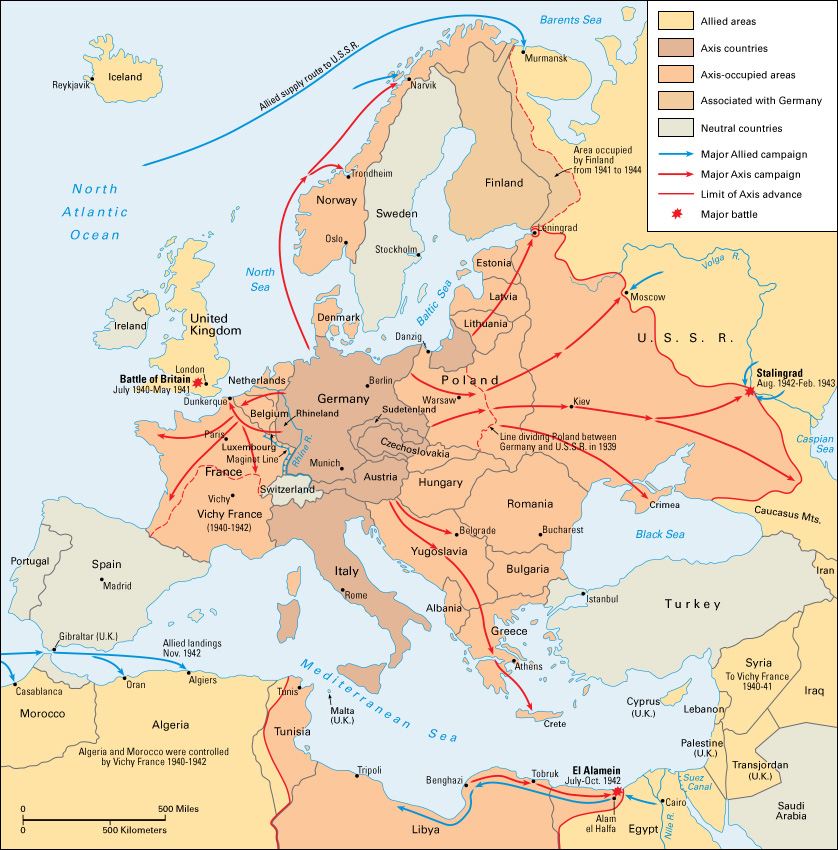
A secret Norwegian resistance army conducted sabotage against the German occupation force. These Norwegians were trained chiefly to join a hoped-for Allied invasion of Norway. Other Norwegians fled their country and trained in Sweden or the United Kingdom for the invasion. Some took part in British commando raids in Norway. After each raid, the Germans shot, tortured, or imprisoned many Norwegians.
Norwegian fighter pilots trained in Canada and operated from bases in the United Kingdom and Iceland. Norway’s merchant fleet carried war supplies for the Allies. The Norwegian navy helped protect Allied shipping, and took part in the invasion of France in 1944.
On May 8, 1945, after Germany fell, the 350,000 German troops in Norway surrendered. Haakon VII returned in triumph on June 7, the 40th anniversary of Norwegian independence. About 10,000 Norwegians died during the war, and about half the merchant fleet was sunk. The far northern counties of Finnmark and Troms lay largely in ruins. See World War II.
Postwar developments.
After the war, loans from the United States helped Norway rebuild its merchant fleet and industries. By the late 1950’s, the Norwegian economy was thriving.
Norway became a charter member of the United Nations in 1945. The next year, Trygve Lie of Norway became the first secretary-general of the UN. In 1949, Norway became a charter member of the North Atlantic Treaty Organization (NATO). But Norway refused to permit NATO bases or nuclear weapons on its territory for fear of angering the Soviet Union, its neighbor on the northeast. (The Soviet Union had been formed under Russia’s leadership in 1922, and it existed until 1991). In 1960, Norway and six other countries formed the European Free Trade Association (EFTA), an economic union (see European Free Trade Association).
In 1957, Haakon VII died. His son became King Olav V of Norway.
Social and economic changes.
In 1966, the parliament passed the National Insurance Act. The program combined such social security plans as old-age pensions, job retraining, and aid for mothers, orphans, widows, widowers, and disabled people. The Norwegians based much of their expanded social welfare program on the Swedish system, which provided extensive benefits.
In 1972, Norway signed a preliminary treaty to join the European Community, an economic organization of European nations that is now incorporated into the European Union. The treaty was submitted for voter approval. Supporters argued that membership would benefit the Norwegian economy, while opponents feared that it would threaten Norway’s national identity and quality of life. In September 1972, Norway’s voters rejected the membership treaty. The Norwegian government then reached a more limited agreement with the European Community to eliminate tariffs on most industrial goods.
Norway began producing petroleum and natural gas from North Sea fields during the early 1970’s. The extraction and processing of petroleum and gas greatly stimulated economic growth. Norway’s petroleum exports help to fund its generous social welfare program.
Political changes.
Norway’s Labor Party held a majority of seats in the Storting from 1935 to 1981, except for brief periods in the 1960’s and 1970’s. In 1981, Labor lost its majority, and Norway entered a period of rapidly shifting coalitions and governments.
In 1981, Gro Harlem Brundtland became the first woman to serve as Norway’s prime minister. Although her first term lasted less than a year, she held the post again from 1986 to 1989 and from 1990 to 1996.
Until 1990, only a king could serve as monarch of Norway. That year, the Storting amended the Constitution to allow women to inherit the throne. Olav V died in 1991. His son, Prince Harald, succeeded him as King Harald V.
In the 1990’s, the European Community grew into the European Union, an organization that promotes political and economic cooperation among member states. In 1992, the Storting voted in favor of joining the European Economic Area. Membership provided greater access to the common European market, but it also required Norway to follow many European Union policies. Many Norwegians urged that the country take the next step and join the European Union. But in November 1994, Norwegians voted against this.
In 1993, Norway fostered peace negotiations between Israel and the Palestine Liberation Organization, which led to the Oslo accords. In the early 2000’s, Norway helped start peace talks between Sri Lanka’s government and that country’s Tamil rebels.
Recent developments.
In elections in 2005, the Labor Party won more seats than any other party. It joined with the Center and Socialist Left parties to form a government. For the first time since the mid-1980’s, the governing coalition held a majority of seats in the Storting.
In July 2011, 77 people died in Norway’s worst terrorist violence since World War II. A domestic terrorist detonated a bomb in downtown Oslo, killing eight people. The bomber then traveled to nearby Utøya Island, where he shot and killed 69 people at a youth camp. The terrorist, a right-wing extremist, claimed he wanted to reverse Norway’s immigration policies and the spread of Islam.
In 2013, the Conservative Party returned to power, forming a coalition government with the Progress Party and other center-right parties. Erna Solberg became the second woman to serve as Norway’s prime minister, and she remained in the post after the 2017 elections. The Labor Party and other left-leaning parties made gains in elections held in 2021. Labor leader Jonas Gahr Støre became prime minister and formed a minority coalition with the Center Party.
